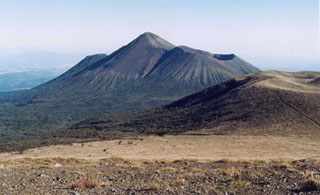Report on Kirishimayama (Japan) — June 1979
Scientific Event Alert Network Bulletin, vol. 4, no. 6 (June 1979)
Managing Editor: David Squires.
Kirishimayama (Japan) Small sulfur flow ejected last winter
Please cite this report as:
Global Volcanism Program, 1979. Report on Kirishimayama (Japan) (Squires, D., ed.). Scientific Event Alert Network Bulletin, 4:6. Smithsonian Institution. https://doi.org/10.5479/si.GVP.SEAN197906-282090
Kirishimayama
Japan
31.934°N, 130.862°E; summit elev. 1700 m
All times are local (unless otherwise noted)
JMA personnel visited the summit crater of Shinmoe-dake, one of the SE group of volcanic edifices in the Kirishima complex, on 23 April. They found a 10-cm-wide sulfur flow that had traveled more than 50 m downslope from one of the summit crater fumaroles, which also was surrounded by scattered, explosively ejected sulfur. The sulfur, molten when it was ejected during the winter, was a dark brown solid in April.
Geological Summary. Kirishimayama is a large group of more than 20 Quaternary volcanoes located north of Kagoshima Bay. The late-Pleistocene to Holocene dominantly andesitic group consists of stratovolcanoes, pyroclastic cones, maars, and underlying shield volcanoes located over an area of 20 x 30 km. The larger stratovolcanoes are scattered throughout the field, with the centrally located Karakunidake being the highest. Onamiike and Miike, the two largest maars, are located SW of Karakunidake and at its far eastern end, respectively. Holocene eruptions have been concentrated along an E-W line of vents from Miike to Ohachi, and at Shinmoedake to the NE. Frequent small-to-moderate explosive eruptions have been recorded since the 8th century.
Information Contacts: JMA.

